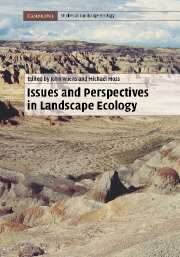Book contents
- Frontmatter
- Contents
- List of contributors
- Preface
- PART I Introductory perspectives
- PART II Theory, experiments, and models in landscape ecology
- PART III Landscape patterns
- PART IV Landscape dynamics on multiple scales
- PART V Applications of landscape ecology
- PART VI Cultural perspectives and landscape planning
- PART VII Retrospect and prospect
- 32 The land unit as a black box: a Pandora's box?
- 33 Toward a transdisciplinary landscape science
- 34 Toward fostering recognition of landscape ecology
- 35 Toward a unified landscape ecology
- Index
- Plate section
- References
33 - Toward a transdisciplinary landscape science
from PART VII - Retrospect and prospect
Published online by Cambridge University Press: 20 November 2009
- Frontmatter
- Contents
- List of contributors
- Preface
- PART I Introductory perspectives
- PART II Theory, experiments, and models in landscape ecology
- PART III Landscape patterns
- PART IV Landscape dynamics on multiple scales
- PART V Applications of landscape ecology
- PART VI Cultural perspectives and landscape planning
- PART VII Retrospect and prospect
- 32 The land unit as a black box: a Pandora's box?
- 33 Toward a transdisciplinary landscape science
- 34 Toward fostering recognition of landscape ecology
- 35 Toward a unified landscape ecology
- Index
- Plate section
- References
Summary
In the current period of transformation from an industrial to a post-industrial, information-rich age with its severe ecological, socioeconomic, and cultural crises, it has become very obvious that a critical point has been reached in the earth's capacity to support both nature and the growing consumption and expectations of its rapidly growing human population. For the first time in the history of the earth, one species – Homo sapiens – has acquired the power to eradicate most life in our natural and semi-natural landscapes, threatening not only their vital life-support functions but also human life itself. To divert the present evolutionary trajectory, which is leading toward breakdown, collapse, and extinction, to a breakthrough toward the sustainable future of nature and the highest attainable quality of human life, there is an urgent need for a far-reaching revolution of environmental and cultural sustainability (Laszlo, 2001). This is imperative in order to reverse global biological and cultural degradation and for dampening the dangerous effects of global warming and the elimination of the scourge of poverty. According to Brown (2001) this sustainability revolution will be driven by the widespread adoption of technological innovations in regenerative and recycling methods and in the efficient utilization of solar and other clean and renewable sources.
There are already many encouraging indicators that this is not an unrealistic Utopia. For example, the use of wind turbines and photovoltaic cells is growing now at over 25% annually, and will very soon be competitive with fossil fuels.
- Type
- Chapter
- Information
- Issues and Perspectives in Landscape Ecology , pp. 346 - 354Publisher: Cambridge University PressPrint publication year: 2005
References
- 7
- Cited by



